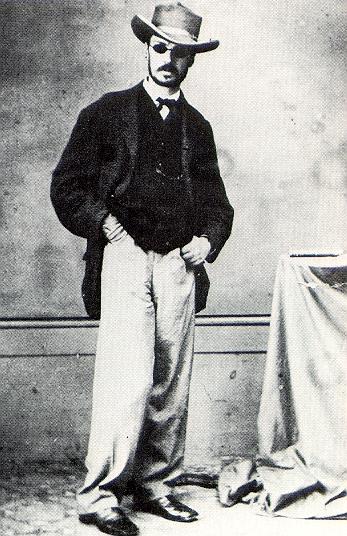Click here and press the right key for the next slide (or swipe left)
(This may not work on mobile or ipad. You can try using chrome or firefox, but even that may fail. Sorry.)
(If the slides don’t work, you can still use any direct links to recordings.)
also ...
Press the left key to go backwards (or swipe right)
Press n to toggle whether notes are shown (or add '?notes' to the url before the #)
Press m or double tap to slide thumbnails (menu)
Press ? at any time to show the keyboard shortcuts
Lecture 03:
Mind & Reality
\def \ititle {Lecture 03}
\def \isubtitle {Mind & Reality}
\begin{center}
{\Large
\textbf{\ititle}: \isubtitle
}
\iemail %
\end{center}
\section{The Question (recap)}
Fact to be explained:
you can think about some objects but not about others.
Q: What sort of relation between a subject and an object has to obtain if the subject is able to think about the object?
Candidate Answer: It’s acquaintance, fundamentally.
Objection: You can think about things you are not acquainted with (Julius Caesar).
Revised Answer: It’s acquaintance plus knowledge by description.
Massive Reduplication Argument: Acquaintance with something is necessary
unless for all you know you have never thought about anything at all.
Let’s try to keep it short
/ex/q/State the basic question about thought (from memory if you can--otherwise it's visible from 2:29 in the video).

Next Steps: Acquaintance and Cognitive Penetration
\section{Next Steps: Acquaintance and Cognitive Penetration}
next steps
alternatives to the Acquaintance View
\section{Pragmatists}
\emph{Reading:} §Putnam, H. (1981). Reason, truth and history. Cambridge University Press, Cambridge., §Dewey, J. (1907). The control of ideas by facts i. The Journal of Philosophy, Psychology and Scientific Methods, 4(8):197–203., §James, W. (1909). The Meaning of Truth : a Sequel to ”Pragmatism”. Longmans Green, London.
‘there are these objects out there. Here is the mind/brain, carrying on its thinking/computing. How do the thinker’s symbols ... get into a unique correspondence with objects and sets out there?’
\citep[p.~51]{Putnam:1981sw}
Putnam, 1981 p. 51
What sort of relation between a subject and an object has to obtain if the subject is able to think about the object?
That tiger looks fierce.
The baby of that tiger is only six months.
pragmatist view : explain the notion of an idea
you have various thoughts about tigers
there is something common to all of these thoughts
(as there is a word common to the sentences).
Not just the tigers themselves
but some psychological component
this is an idea
Our question is one that famous philosophers have been asking for a while ...
I want to start by asking you to read these quotes (see handout) and think about them.
OBJECTIVE 1 : let’s try to understand them
\section{The Question’s History}
‘there are these objects out there. Here is the mind/brain, carrying on its thinking/computing. How do the thinker’s symbols ... get into a unique correspondence with objects and sets out there?’
\citep[p.~51]{Putnam:1981sw}
Putnam, 1981 p. 51
‘the implication of the thinking situation is of some ‘correspondence’ ... the problem of its nature and valid determination remains the central question of any theory of thinking’
\citep[p.~200]{Dewey:1907ka}
Dewey, 1907 p. 200
‘That truth is the correspondence of a representation with its object is, as Kant says, merely the nominal definition of it. ... But what does this correspondence or reference of the sign, to its object, consist in?’
\citep[p.~390/5.553]{Peirce:1906gu}
Peirce, 1906 p. 390/5.553
James in Brazil in 1865.
‘I say that we know an object by means of an idea whenever we ambulate towards the object under the impulse which the idea communicates’
\citep[p.~140]{James:1909vm}
James, 1909 p. 140
‘The pointing of our thought to the tigers is known simply and solely as a procession of mental associates and motor consequences that follow on the thought, and that would lead harmoniously, if followed out, into some ideal or real context, or even into the immediate presence, of the tigers. … It is even known, if we take the tigers very seriously, as actions of ours which may terminate in directly intuited tigers, as they would if we took a voyage to India for the purpose of tiger-hunting and brought back a lot of skins of the striped rascals which we had laid low’
\citep[p.~44--5]{James:1909vm}
James, 1909 p. 44-5
Pragmatist View
There is nothing more primitive than thought which explains the possibility of thought.
Awareness of things plays no role in explaining the possibility of thought.
There is a psychological component common to all thoughts about tigers, the ‘idea’ of tigers.
Acquaintance View
Acquaintance is more primitive than thought and explains the possibility of thought.
Awareness of things plays an indespensable role in explaining the possibility of thought.
Only the tigers themselves are common to all thoughts about tigers.
Fact to be explained:
you can think about some objects but not about others.
/ex/TorF/qq/On the pragmatist view, there is something more primitive than thought which explains the possibility of thought.|On the Acquaintance View, there is something more primitive than thought which explains the possibility of thought.
\section{What Is Perception?}
\emph{Reading:} §Davidson, D. (1999). Replies to critics. In Hahn, L. E., editor, The Philosophy of Donald Davidson. Open Court, Chicago., §Davidson, D. (1997). Seeing through language. In Preston, J., editor, Thought and Language, Royal Institute of Philosophy Supplement, vol. 42. Oxford University Press, Oxford., §Dretske, F. (2000). Simple seeing. In Perception, Knowledge and Belief. Cambridge University Press, Cambridge., §Dretske, F. (1969). Seeing and Knowing. Routledge, London.
| topic | question |
| Acquaintance | How do your thoughts connect to the things about which you think? |
| Cognitive Penetration | How, if at all, do your thoughts influence your perceptions? |
| Awareness | What good is your perceptual awareness of the objects around you? |
| Sense & Reference | Why are some numerical identities informative? |
| Metaphysics | What is necessary for your personal survival? |
| Action | Of the events involving you, what determines which are your actions? |
| Induction | What is it for an observation to provide evidence for a scientific theory? |
perception
visual
auditory
haptic
olfactory
vestibular
proprioceptive
nocioceptive
...
stimulus
-> receptors
-> processing
-> sensation/experience/judgement/arousal/response
It’s the processing that I will refer to as perception.
The processing is astonishingly sophisticated, as you know
just from the fact that moving your eyes does not interfere
with your ability to prevent movement.
People say funny stuff about perception
‘I see Ayesha’
‘I see that Ayesha has a question’
‘I see that Ayesha wants to ask question’
How do you know about it?
perceive it
vs
percieve indicator, infer its presence
an apparent contradiction
‘perception operates within the ambit of propositional thought’
‘Perception is propositional: when we look or feel or hear, we believe.’
Davidson 1999 p. 730 & p. 732
\citep{Davidson:1999il}
‘Seeing sights and hearing sounds does not require thought with propositional content’
Davidson, 1997 p. 22
\citep{Davidson:1997wj}
apparently contradictory arguments ...
Siegel & Shuster, 1939 (Issue 1)
Does Lois see the unbearable coward?
Does Lois see the unbearable coward?
1. Lois sees Superman.
3. Clark is the unbearable coward.
Therefore:
4. Superman is the unbearable coward.
Therefore:
5. Lois sees the unbearable coward.
1. If Lois could see the unbearable coward, she’d know where he is.
2. Lois does not know where the unbearable coward is.
Therefore:
3. Lois cannot see the unbearable coward.
’Did you see the alpaca?’
’Yes’
‘Why did’t you mention it to me?’
’I thought it was a sheep’
You can see an alpaca without knowing that it is an alpaca.
Simple Seeing (aka Nonepistemic Seeing)
Dretske introduces the notion of \emph{simple seeing}
(see \citealp[chapter 6]{Dretske:2000ky}; the same thing is called as ‘nonepistemic seeing’ in \citep{Dretske:1969td}).
The key characteristic of simple seeing: if X is the F, then \emph{S sees X} is equivalent to \emph{S sees the F}.
Key characteristic of simple seeing: if X is the F, then S sees X is equivalent to S sees the F.
\citep[p.~54]{Dretske:1969td}.
Dretske, 1969 chapter II; Dretske 2000 chapter 6
‘Here lies the fatal flaw in [...] the philosophy of mind,
for, in
using as evidence what seems reasonable or persuasive, philosophers
ultimately rely on their own introspections.
They look inside themselves
in an attempt
to discover the design of the mind’
\citep[p.~380]{bridgeman2004philosophy}
Bridgeman, 2004 p. 380
‘Seeing objects is a way of getting information about them. .[...]
What makes it X
(rather than Y) that we see is that the information these internal events
carry is information about X (rather than Y). Everything else [...]
is [...] something the scientist, not
the philosopher, should provide’
Dretske 2000, p. 112
‘Seeing objects is a way of getting information about them. What makes it
seeing (rather than, say, hearing) is the intrinsic character of those
events occurring in us that carry the information. What makes it X
(rather than Y) that we see is that the information these internal events
carry is information about X (rather than Y). Everything else [...]
is [...] something the scientist, not
the philosopher, should provide’
\citep[p.~112]{Dretske:2000ky}.
Simple Seeing
Key characteristic of simple seeing: if X is the F, then S sees X is equivalent to S sees the F.
Dretske, 1969 chapter II; Dretske 2000 chapter 6
Does Lois see the unbearable coward?
1. Lois sees Superman.
3. Clark is the unbearable coward.
Therefore:
4. Superman is the unbearable coward.
Therefore:
5. Lois sees the unbearable coward.
1. If Lois could see the unbearable coward, she’d know where he is.
2. Lois does not know where the unbearable coward is.
Therefore:
3. Lois cannot see the unbearable coward.
Simple Seeing
Key characteristic of simple seeing: if X is the F, then S sees X is equivalent to S sees the F.
Dretske, 1969 chapter II; Dretske 2000 chapter 6
an apparent contradiction
‘perception operates within the ambit of propositional thought’
‘Perception is propositional: when we look or feel or hear, we believe.’
Davidson 1999 p. 730 & p. 732
\citep{Davidson:1999il}
‘Seeing sights and hearing sounds does not require thought with propositional content; perceiving how things are does ’
Davidson, 1997 p. 22
\citep{Davidson:1997wj}
I guess this is just Dretske’s distinction between simple seeing and
all the other stuff that philosophers call seeing.
Simple Seeing
Key characteristic of simple seeing: if X is the F, then S sees X is equivalent to S sees the F.
Dretske, 1969 chapter II; Dretske 2000 chapter 6
People say funny stuff about perception
‘I see Ayesha’
‘I see that Ayesha has a question’
‘I see that Ayesha wants to ask question’
How do you know about it?
perceive it
vs
percieve indicator, infer its presence
Which of these four plausibly reports a case of simple seeing.
One last thing, I almost forgot ...
Simple Seeing Perceiving
Key characteristic of simple seeing perceiving: if X is the F, then S sees perceives X is equivalent to S sees the F.
Dretske, 1969 chapter II; Dretske 2000 chapter 6
/ex/TorF/qq/The statement, ‘I see Ayesha’ plausibly reports a case of simple seeing.|The statement, ‘I see Ayesha’s hand’ plausibly reports a case of simple seeing.|The statement, ‘I see that Ayesha has a question’ plausibly reports a case of simple seeing.|The statement, ‘I see that Ayesha wants to ask question’ plausibly reports a case of simple seeing.




